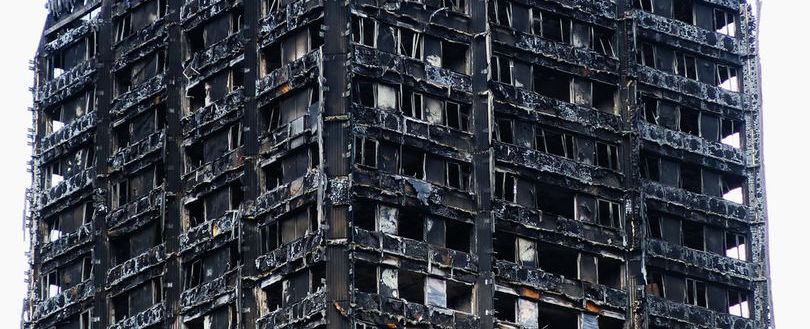
Cladding Panels Failed Fire Tests 13 Years Prior to Grenfell Tragedy
Like it? Share it!
17 September 2021
Panels, commonly used on buildings in the UK, failed fire tests carried out in 2004. The results, marked "Commercial in confidence", were circulated within an industry advisory group.
The 2004 results were among the first from a British test of full-scale building systems, developed in the late 1990s when there were growing concerns in Parliament about the risks of cladding. The tests were part of research commissioned by the then Labour government to determine what standards building systems should have to meet.
Five cladding systems were tested, including one with aluminium panels, although the primary aim was not to assess the risk of particular designs. The aluminium and plastic cladding at Grenfell has been blamed for spreading the fire.
Two were constructed from high-pressure laminate (HPL) boards, formed from wood, or paper fibre, widely used on modern apartment blocks in the UK. In the tests, all five cladding systems were judged to have failed against "proposed performance criteria".
Most of the tests were carried out without using "fire breaks" - extra components which should be fitted to block the spread of flames. However, fire breaks were used in one high-pressure laminate panel system, but it still failed.
The UK Cladding Action Group stated that these test results are "staggering new evidence which shows the government and its advisers knew these materials were dangerous, but simply stood back and allowed them to be installed on hundreds of thousands of buildings”.
"The British state knew from this moment on that it was gambling with a disaster in a high-rise, but it chose not to act."
Jonathan Evans, director of Ash and Lacy, a major UK supplier of cladding systems, said he had never seen the results, and described them as "really vital bits of information" which would have helped assess fire risks after Grenfell.
He said that when poor test data is not made public, it creates a bias towards tests with successful outcomes.
He said a lack of public information about cladding systems in the 2000s may have resulted in governments not abandoning a controversial British Standard for building materials, known as Class 0.
The Grenfell Tower inquiry has heard evidence that this standard was much easier to meet than a stricter European classification, and that keeping it as an option in England and Wales allowed combustible materials to be installed on thousands of buildings.
Dr. Evans stated that if Class 0 had been abandoned and a ban on combustible materials introduced, Grenfell might not have happened.
The Ministry of Housing, Communities and Local Government (MHCLG) described the 2004 tests as "experimental... for a different purpose" than the rounds of testing ordered in the wake of the Grenfell disaster.
They were carried out "to check the criteria for testing" rather than to assess the "intrinsic safety of building materials", officials said.
The findings fed into a review of technical standards used by building designers to assess the safety of cladding.
An MHCLG spokesman said: "We are taking action to improve building safety where successive governments have failed, through our Building Safety Bill, which marks the biggest improvements to building safety in 40 years, with more rights and protections for residents and a £5bn investment to remove unsafe cladding.
"The new Building Safety Regulator will enforce a more stringent regulatory regime for buildings over 18m and oversee the safety and performance of all buildings, ensuring products are removed from the market if they do not meet regulation."
Next month the Grenfell Tower public inquiry will begin examining evidence of what governments knew about the risks of cladding fires before the 2017 disaster, and what they did about it.
A note from the FIA:
Here at the FIA, we are committed to responding to the Grenfell Tower tragedy successfully.
The FIA Building Safety Information Portal [BSIP] was introduced last year to host completed EWS-1 forms and make them publicly available, enabling everyone including homeowners, prospective buyers, valuers, and lenders to readily access a building's EWS-1 form through a central location.
The FIA play a crucial role in ensuring all individuals registered to complete EWS-1 Surveys have the required qualifications and credentials, in addition to checking all forms before they are approved.
Earlier this month, UK Finance announced that seven mortgage lenders will cover the cost of some 250 fire professionals to register on the Portal and for up to 6,000 EWS-1 forms to be made available. As a result, it is free to upload EWS-1 forms to the portal until October 11th, we strongly advise that you take advantage of this opportunity.
Related training
Related news
Related resources
-
Euralarm-FAQs-re-Environmental-Product-Declarations-EPDs.pdf 1
27 November 2025
-
Fire Risk Assessors Standard Scope of Services
07 August 2025
